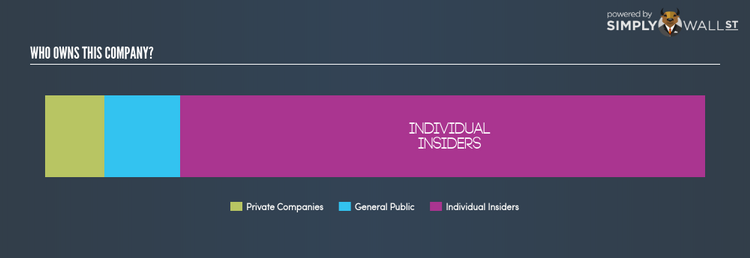Who Owns Bojun Agriculture Holdings Limited (ASX:BAH)?

In this article, I’m going to take a look at Bojun Agriculture Holdings Limited’s (ASX:BAH) latest ownership structure, a non-fundamental factor which is important, but remains a less discussed subject among investors. Ownership structure has been found to have an impact on shareholder returns in both short- and long-term. Since the same amount of capital coming from an activist institution and a passive mutual fund has different implications on corporate governance, it is a useful exercise to deconstruct BAH’s shareholder registry.
See our latest analysis for Bojun Agriculture Holdings
Insider Ownership
I find insiders are another important group of stakeholders, who are directly involved in making key decisions related to the use of capital. In essence, insider ownership is more about the alignment of shareholders’ interests with the management. BAH insiders hold a significant stake of 79.43% in the company. This level of insider ownership has been found to have a negative impact on companies with consistently low PE ratios (underperformers), while it has been positive in the case of high PE ratio firms (outperformers). It may be interesting to take a look at what company insiders have been doing with their holdings lately. While insider buying is possibly a sign of a positive outlook for the company, selling doesn’t necessarily indicate a negative outlook as they may be selling to meet personal financial needs.
General Public Ownership
A big stake of 11.48% in BAH is held by the general public. With this size of ownership, retail investors can collectively play a role in major company policies that affect shareholders returns, including executive remuneration and the appointment of directors. They can also exercise the power to decline an acquisition or merger that may not improve profitability.
Private Company Ownership
Another group of owners that a potential investor in BAH should consider are private companies, with a stake of 9.09%. While they invest more often due to strategic interests, an investment can also be driven by capital gains through share price appreciation. An ownership of this size indicates a strong financial backing and has the potential to influence BAH’s business strategy. Thus, investors should dig deeper into BAH’s business relations with these companies and how it can affect shareholder returns in the long-term.
Next Steps:
A relatively significant holding of company insiders could mean high alignment with shareholders. But at the same time, investors should be aware of the level of influence executives could have on governance decisions. However, if you are building an investment case for BAH, ownership structure alone should not dictate your decision to buy or sell the stock. Rather, you should be looking at fundamental drivers such as Bojun Agriculture Holdings’s past track record and financial health. I urge you to complete your research by taking a look at the following:
Financial Health: Is BAH’s operations financially sustainable? Balance sheets can be hard to analyze, which is why we’ve done it for you. Check out our financial health checks here.
Valuation: What is BAH worth today? Is the stock undervalued, even when its growth outlook is factored into its intrinsic value? The intrinsic value infographic in our free research report helps visualize whether BAH is currently mispriced by the market.
Other High-Performing Stocks: Are there other stocks that provide better prospects with proven track records? Explore our free list of these great stocks here.
NB: Figures in this article are calculated using data from the last twelve months, which refer to the 12-month period ending on the last date of the month the financial statement is dated. This may not be consistent with full year annual report figures.
To help readers see pass the short term volatility of the financial market, we aim to bring you a long-term focused research analysis purely driven by fundamental data. Note that our analysis does not factor in the latest price sensitive company announcements.
The author is an independent contributor and at the time of publication had no position in the stocks mentioned.


